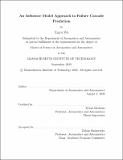An influence model approach to failure cascade prediction
Author(s)
Wu, Xinyu(Aerospace scientist)Massachusetts Institute of Technology.
Download1227505511-MIT.pdf (2.608Mb)
Other Contributors
Massachusetts Institute of Technology. Department of Aeronautics and Astronautics.
Advisor
Eytan Modiano.
Terms of use
Metadata
Show full item recordAbstract
Power systems are vulnerable to widespread failure cascades which are challenging to model and predict. The ability to predict the failure cascade is important for contingency analysis and corrective control designs to prevent large blackouts. In this thesis, we study an influence model framework to predict failure cascades and try to figure out their underlying pattern in real power systems. A hybrid learning scheme is proposed to train the influence model from simulated failure cascade sample pools. The learning scheme firstly applies a Monte Carlo approach to quickly acquire the pairwise influences in the influence model. Then, a convex quadratic programming formulation is implemented to obtain the weight of each pairwise influence. Finally, an adaptive selection of threshold for each link is proposed to tailor the influence model to better fit different initial contingencies. We test our framework on a number of large scale power networks under both DC and AC flow models, and verify its prediction performance through numerical simulations in both accuracy and efficiency. Under limited training samples, the proposed framework is capable of predicting the final state of links within 10% error rate, and the failure cascade size within 7% error rate in most cases, along with around two magnitude of time cost reduction in large systems compared with flow calculation method. We also show that the trained influence model can unveil instructive insights on cascade properties such as influence sparsity, the relationship between influence value and topological distance of different transmission links, and critical/non-critical initial contingencies.
Description
Thesis: S.M., Massachusetts Institute of Technology, Department of Aeronautics and Astronautics, September, 2020 Cataloged from student-submitted PDF of thesis. Includes bibliographical references (pages 63-65).
Date issued
2020Department
Massachusetts Institute of Technology. Department of Aeronautics and AstronauticsPublisher
Massachusetts Institute of Technology
Keywords
Aeronautics and Astronautics.